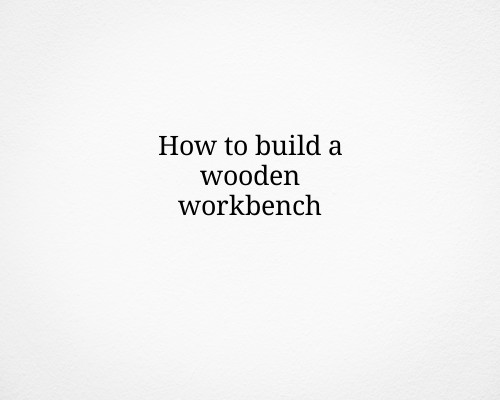Building a wooden workbench is a rewarding and practical project that can be customized to suit your specific needs. Whether you’re working on small craft projects or larger woodworking tasks, a sturdy workbench is essential for any workshop. Here’s a step-by-step guide to help you build a solid wooden workbench.
Materials Needed:
- 2×4 lumber (or similar sturdy wood for the frame and legs)
- Plywood (for the work surface, preferably 3/4 inch thick)
- Wood screws (3-inch screws for the frame and shorter screws for attaching the plywood)
- Wood glue (for added stability)
- Corner brackets (optional for extra reinforcement)
- Wood finish or sealant (to protect the surface)
Tools Required:
- Measuring tape
- Saw (circular saw, miter saw, or handsaw)
- Drill with bits for pilot holes and screwdriver attachments
- Wood clamps
- Sandpaper or power sander
- Square or framing square
- Woodworking clamps
Step 1: Design and Plan
Before you start cutting wood, determine the size of your workbench. Common dimensions are 48 inches long by 24 inches wide and about 34–36 inches tall. These measurements can be adjusted based on the space available and your specific requirements.
Step 2: Cut the Lumber for the Frame
- Cut the legs: Cut four pieces of 2×4 lumber to the height you want for your workbench (around 34 inches is standard for most people).
- Cut the stretchers: You will need two stretchers for the long sides (48 inches) and two for the short sides (24 inches). These pieces connect the legs and provide stability to the frame.
- Cut the supports: For additional stability, cut four shorter pieces of 2×4 to support the top of the frame (around 22 inches for the long pieces and 16 inches for the short ones).
Step 3: Assemble the Frame
- Assemble the legs and stretchers: Using wood screws and wood glue, attach the stretchers to the legs to form a rectangular frame. Make sure the angles are square and the frame is level.
- Add the supports: Attach the shorter support pieces inside the frame. These pieces should be positioned slightly lower than the top of the legs to allow for the thickness of the work surface.
Step 4: Attach the Work Surface
- Cut the plywood: Cut a piece of plywood to fit the top of the frame. The plywood should be the same size as the frame or slightly overhanging for a more aesthetic look. Sand the edges for smoothness.
- Attach the plywood: Secure the plywood onto the frame using wood screws or nails. Pre-drill holes to prevent the wood from splitting, and ensure that the screws are driven in at an angle for extra holding power. Alternatively, you can use wood glue before screwing it down to add extra strength.
Step 5: Reinforce the Workbench
To make the workbench more durable, consider adding corner brackets or additional wood supports underneath the frame. This step is especially important if you plan on using the bench for heavy-duty projects.
Step 6: Sand and Finish
- Sand the surface: Sand the entire surface of the workbench with a power sander or by hand to remove rough spots and ensure a smooth, even finish.
- Apply a finish: Once the workbench is sanded, apply a wood finish or sealant to protect the surface from moisture, stains, and general wear. A polyurethane finish is a great choice for durability.
Step 7: Optional Additions
- Storage: Add shelves or drawers beneath the workbench for tool storage. This can be easily done by attaching plywood to the frame and adding dividers or drawer slides.
- Workbench Top Protection: For more protection, you can cover the top with a sheet of hardboard or plywood to prevent damage to the surface from repeated use.
Step 8: Enjoy Your New Workbench
Once the workbench is assembled and finished, it’s ready to use! Set it up in your workshop and enjoy the added functionality it provides. With proper care and maintenance, this workbench will last for years.
For more woodworking projects and detailed plans, you might be interested in exploring Teds Woodworking Course for step-by-step guides and plans tailored to your woodworking needs.
Click here to access Teds Woodworking Course: Teds Woodworking Course
